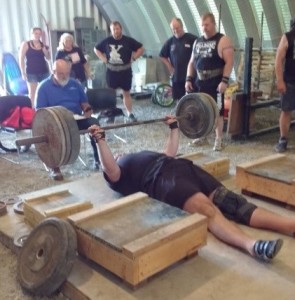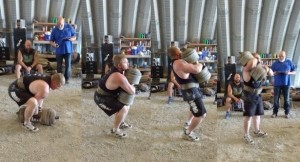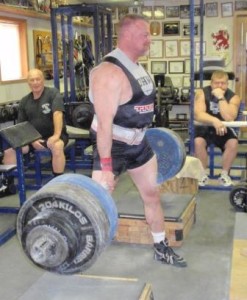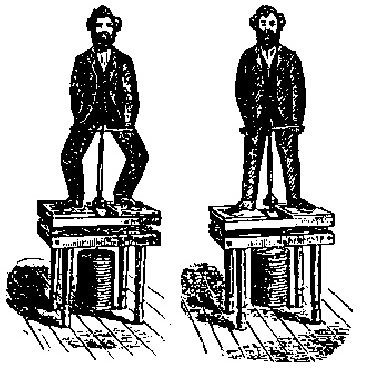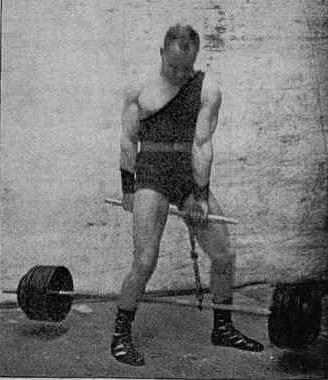MY OTSM EXPERIENCE
By Ben Edwards
It was great once again to drive up to Eric Todd’s gym and get some Old Time Strongman work in. I met a few “new” people this time. Eric mentioned in his write-up that the turnout was great, and it was. There was not a single person there who wasn’t excited to see a fellow competitor set a record or succeed on a lift that they fought several times during a minute to get.
This is my 2nd OTSM comp. I did the 2016 OTSM – also at Eric’s gym – and had a great time then too.
The first thing that always strikes me when I walk into the gym is the sheer size of the place. What makes that even more impressive is how much equipment is packed into the cavernous space. I never get tired of just wandering around the area and checking out the plethora of training tools that populate the area.
When the competitors started filing in, someone greeted “Leroy” and I almost said “Nice to meet you, Leroy.” But then I caught on that the inside joke is that Eric’s brother Chris answers to “Leroy.” Chris was very congenial and I enjoyed talking to him between events.
It was great getting to see Thom Van Vleck again. We were all glad to have him judging, but I think he should’ve been competing. On a side note, I was floored when he told me he had done 300 pounds on the Dumbbell to Shoulder. I BARELY got 150 pounds. And it took me two attempts. I am bruised and sore and really can’t imagine how Eric must feel after his 313 pound success.
Like Eric mentioned in his write-up, it was interesting to see during Thor’s Hammer attempts the styles of performance used. There was the swing style, which I prefer. And the snatch style, which Eric uses exclusively. The snatch style is quite a bit harder for me on the wrist. I came into the comp at 40 pounds and that was easy. Then 50 pounds. Got it on the first try, but it felt pretty hard. Then 55 pounds was very hard and I kind of pulled it out of nowhere, because it did not feel good. It was pretty cool watching Eric smash 60 pounds up for the win. I usually feel pretty efficient on the Thor’s Hammer, but I felt just a bit “off” at the contest. Heather had possibly the smoothest form of anyone there in her Thor’s Hammer lifts.
Second event was the Hackenschmidt Floor Press. I enjoyed watching the big lifters go well north of 300 pounds on this. I was content that my shoulder held up under 225 pounds and my 2nd attempt with 250 pounds, so I skipped my 3rd attempt. Abe was very impressive on this event when you consider bodyweight vs. weight lifted! I got a kick out of watching Scott do this event because his torso is so thick that the bar is pretty much just resting on his chest when he starts the lift.
I was not looking forward to the Kennedy Lift, because the three times I tried to train it my back did not agree with it. But it turns out my fears were not warranted. I still had to baby my back, but went 120 pounds over what I was able to do in my garage during training. There was a funny incident during my 405 pound opener. I lifted the bar, without making sure Thom was ready to judge, and after holding it at lockout for a few seconds I realized that I hadn’t told Thom I was ready to take my attempt, so I asked if I should redo the lift and scolded myself for a beginner blunder. 2nd attempt was 500 pounds and that went right up. Took 525 pounds for a 3rd attempt and definitely had more in me. Didn’t ask for a 4th attempt because Al Myers has the record in the 110kg weight class with 750 pounds! I was very impressed with Heather Tully because her final lift looked fast and like she had a lot more in her. Chad and Greg pulling 755 pounds was a sight to see. Super impressive!
I had not even attempted to try the Dumbbell to Shoulder event. No plans to do that in this lifetime after barely succeeding with 150 pounds. I warmed up with a super easy 120 pounds and almost bombed out when I called for 150 pounds as my opener. I missed it on the first attempt and then barely made it on my 2nd attempt. Watching Eric do 313 pounds on this was one of the most impressive things I’ve ever seen. Partly because the lift just saps the breath and life out of you the longer it goes on. John Douglas had a nice fight with 200 pounds. I liked Dean’s method of grabbing the dumbbell by both ends and kind of power curling it to his shoulder instead of dry humping it up his body like I ended up doing. Denny seemed to be pretty efficient too on the Dumbbell to Shoulder. The following photo sequence is not Eric’s heaviest lift, but it is the only sequence I got on camera.
I didn’t realize it until after we finished the Dumbbell to Shoulder that we were actually going to be pulling attempts on the Lurich Lift – the exhibition lift. I did much better than I thought I would and ended up pulling 405 pounds and bailing on 455 pounds because my back felt like it was going to give me issues. Chad schooled everyone by pulling 605 pounds! Lance pulled 315 pounds, which is impressive considering the lift doesn’t suit him anatomically.
One other note is that I asked Eric if I could buy one of his highland games stones for my Braemar practice. He told me to pick out the one I wanted and let me have it. So thanks again, Eric! I put the stone in my daughter’s car seat and strapped it in like a baby for the ride home. I threw it a few times when I got home and my one good remaining shoulder unfriended me later that night.
